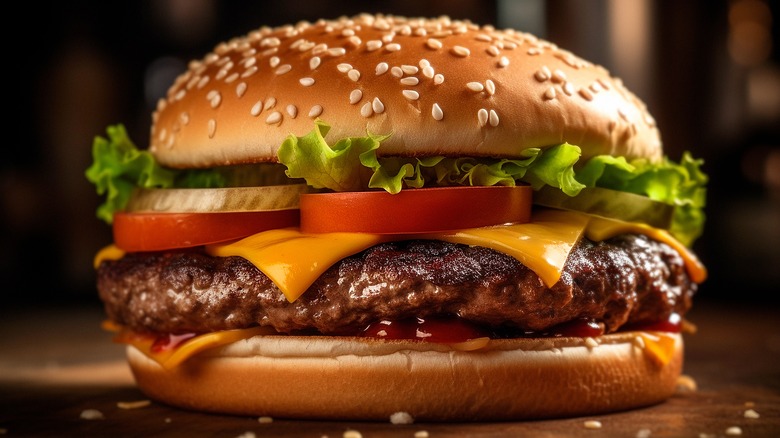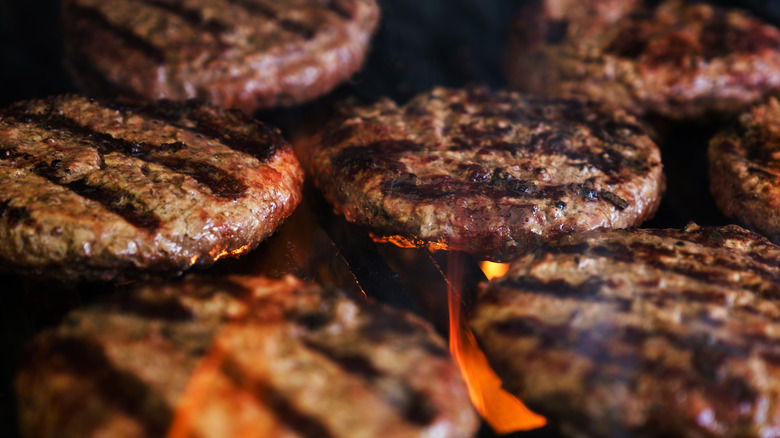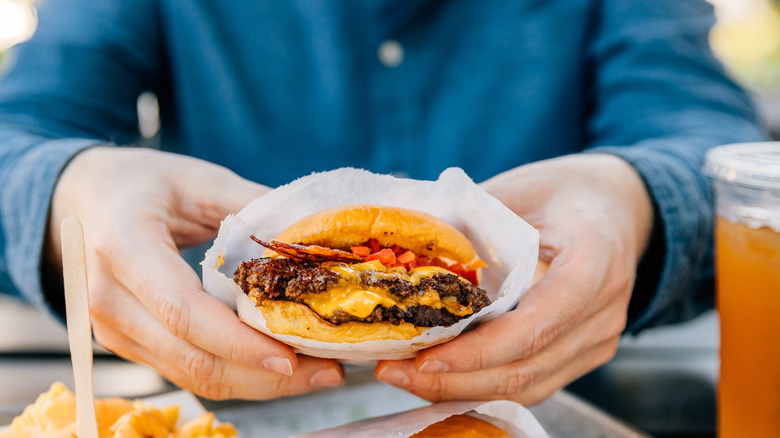How Many Burgers Should You Be Able To Make Per Pound Of Meat?
Hosting a barbecue can be a total joy when the weather permits, gathering friends on a sunny day around the grill, sipping seasonal drinks, and bathing in the aromas of the smoky, flame-kissed food. Of course, homemade burgers are a treat no matter the season or method of cooking, so it helps to have a solid go-to recipe you can rely on for all occasions.
When it comes to homemade burgers, there are some great tips and tricks for the best patties ever, but in preparing your strategy, it always helps to have a reliable idea of how much meat to purchase. Believe it or not, a fast food menu has been providing a good answer since 1971 when McDonald's introduced their Quarter Pounder. While you can certainly make daintier patties or deliver some monster options for super-hungry guests, a solid go-to size for your creation is a ¼ pound (or 4 ounces), which means you can expect four burgers per pound of meat. This information is helpful for home cooks who are just looking to plan ahead for family or solo dinners, too, and is applicable whether you're talking beef, veggie, seafood burgers, or otherwise.
The ideal quarter-pound burger
Your burgers will naturally shrink depending, in part, on how much moisture and fat your meat contains, as well as the temperature at which they're cooked. When choosing your meat blend, note the lean meat-to-fat ratio. For example, 80/20 or 90/10; since volume reduces as fat melts during cooking, the former will have slightly more shrinkage. That said, many believe 80/20 to be an ideal, well-balanced ratio for burgers since that fat delivers flavor. Additionally, resist the urge to fire your burgers up over super-high heat even if you're feeling hangry. Not only will you wind up with a scorched exterior, but those delicious fats and juices will be sucked out, leaving behind dry and tough hockey pucks instead.
There's more science to keeping your burger from shrinking on the grill, and it hinges on the formation of your patties. Make sure you don't knead your meat for more than 30 to 45 seconds, as meat that has been beaten up can result in a tightening of proteins and shrinkage when it hits the grill. Form your patties as loosely as possible, to about 4 inches in diameter and 1 inch thick; this patty will work well with a standard 3-inch burger bun, and you won't run the risk of having your meat disappear into the bread after the inevitable shrinkage.
Scaling and strategizing your burger creations
The size of your burger will also impact cook time and doneness. At about 1 inch thick, your quarter pounder should reach medium in about eight minutes over medium to high heat. You can vary the size if the occasion calls for it. If you're into the smash burger craze, a 2-ounce burger patty, about ½-inch thick, is the standard (and can cook to medium on a flat-top griddle or pan in about five minutes). From there, you can decide if you want double smash burgers with two smash patties on the same bun or create eight individual single-patty burgers.
If you want to go down the slider route (and try your hand at copycat White Castle slider mini masterpieces, for example), simply scale down to that same 2-ounce patty, but in this case, about a ½-inch thick, which will cook in about two to three minutes per side for a pink center.
No matter what size you select for your burger feast, there's no question you'll be putting a crowd favorite on the table. And once you remove the guesswork about yield, you can focus on the most important factor: creating and enjoying your burgers.


